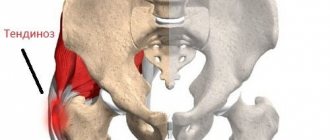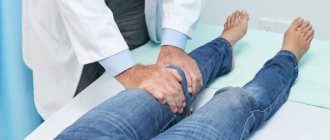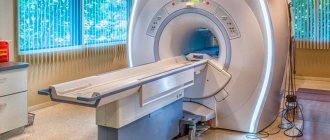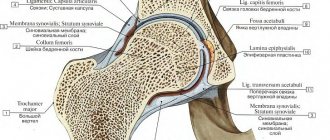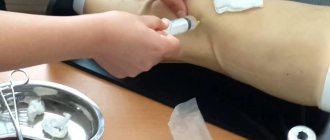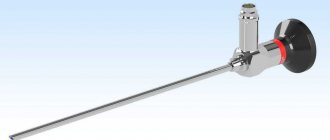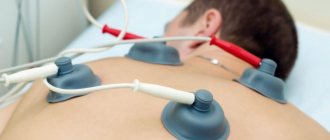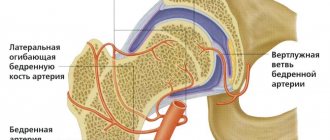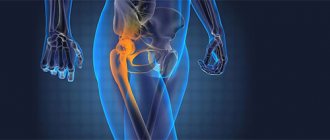Long-term, persistent hip pain may be a symptom of a condition called hip tendinosis. The pathology is common, since it is these large joints that account for 80% of the load of the total body weight. The disease leads to unpleasant consequences: destruction of cartilage and disability of the patient. Tendinosis is easy to diagnose and responds well to therapy. The main task of the patient is to consult a doctor in a timely manner.
Causes of tendinosis
The pathology is expressed by an inflammatory process in the tendons that connect the muscles and joints of the hips.
As a result of the development of the disease, motor function is impaired, ligaments are stretched or torn, cartilage tissue is erased, joints are destroyed and bones are deformed. Tendinosis affects people over 40 years of age, professional athletes and those whose work involves constant physical activity. The following are the reasons for the development of tendinosis:
- advanced age;
- arthritis and arthrosis of the joints;
- congenital anatomical anomalies of the skeleton;
- infectious inflammation of the joint;
- frequent injuries;
- metabolic disorders in the body;
- hormonal imbalance;
- incorrect posture;
- frequent wearing of high-heeled shoes.
How to get rid of tendinosis?
Most often, when diagnosing the disease at an early stage, doctors can treat it with conservative methods. In case of development or chronic form of tendinosis, surgical intervention is used to remove the affected areas of tendon tissue.
Patients need to prepare mentally - the therapy will be long-term, from 4-6 weeks to several months. Moreover, the course of treatment includes not only medications and physiotherapy, but also movement restrictions.
Immobilization
To relieve pain, it is necessary to limit movement in the hip; a splint or orthosis can successfully cope with this. Sometimes it is possible to use only elastic bandages - the limb is compressed, blood flow and swelling along with it are reduced.
It is best to apply cold compresses to reduce inflammation. It is important to remember that you can use cold locally for no more than 20 minutes, then you need to take a break for at least a quarter of an hour - half an hour.
Drug treatment
Medicines, primarily tablets and ointments, are used to quickly eliminate inflammation. For tendinosis, strong drugs are usually not prescribed, in particular drugs from the corticosteroid group; non-steroidal anti-inflammatory drugs (NSAIDs) can cope well with the inflammatory process. The list of medical prescriptions may include:
- Diclofenac;
- Ibuprofen;
- Ketanol.
Usually these drugs are taken in tablet form, the course of treatment is usually up to 14 days. The dosage is chosen by the doctor depending on the patient’s condition. NSAIDs in the form of ointments and gels are also used, but this form of release is switched to after the end of taking capsules and tablets. Among the most popular external use products are:
- Voltaren Emulgel;
- Diclofenac;
- Dolobene.
The main contraindications to ointments and gels are dermatological problems and violations of the integrity of the dermis. Also, those who have individual intolerance to the components of the composition will have to refuse treatment.
Types of pathology
Tendinosis is caused by inflammation in the joints.
According to the nature of its occurrence, tendinosis occurs:
- Aseptic. Occurs as a result of external influence on the tendon, such as injury.
- Infectious. Develops due to infection of the connective tissue or joint.
In addition, when making a diagnosis, the localization of the pathological process is taken into account. Tendinosis can occur in the following areas:
- adductor longus tendon;
- connection of the iliopsoas muscle;
- abductor tendon.
Features of treatment
Timely treatment will help stop negative changes in connective tissues. A positive result can be observed when using complex treatment.
In this case, therapy should include:
- medicinal drug;
- massage;
- physiotherapy;
- physiotherapy;
- surgical intervention.
Physiotherapeutic methods include ultrasound and magnetic therapy. During treatment, you need to limit physical activity and use special physical therapy.
For such a disease, doctors recommend wearing fixing bandages. If the disease takes complex forms, then surgical treatment and antibiotic therapy can be used.
Surgical intervention is used when conservative treatment has not brought the desired result.
How to recognize?
During movement, a characteristic crunching sound appears in the joint.
The first sign of the development of pathology is pain. Its intensity is determined by the stage of development of tendinosis. In the early stages, the joint hurts only after prolonged physical activity. The pain disappears in a state of rest. Minor discomfort appears in the belt, pelvic floor and thigh area. The patient does not always pay attention to the alarming symptom. As the disease progresses, the pain becomes stronger, does not depend on the amount of physical effort and torments the patient even during sleep. In addition, tendon tendinosis is expressed by the following symptoms:
- impaired joint mobility;
- feeling of severe sharp pain when palpating the joint;
- cracking or crunching when bending a joint;
- changes in the skin of the affected joint: the skin turns red, becomes rough and peels.
Preventive actions
To prevent the occurrence of the disease, experts recommend adhering to certain rules:
- Elimination of any excessive stress – when playing sports or active recreation, patients often neglect proper rest. The result of ignoring the body's demands is a slow recovery of microtraumas received during exercise.
- Performing a number of exercises requires an even distribution of loads on muscle tissue. Violation of technique, ignoring pre-stretching invariably leads to minor injuries to the hip tissue. Proper preliminary preparation before any training will help avoid the danger of microtrauma.
- Office employees and other representatives of mental work should take short (5-minute) breaks every hour. During this period, you are allowed to do light warm-up exercises, just walk around the office. Ideally, you should purchase a specialized orthopedic chair.
- Controlling body weight – excess weight negatively affects the condition of the hip joint. For obesity of any severity, it is recommended to switch to dietary nutrition in order to normalize weight indicators.
- Changing the daily diet - incoming food must contain a sufficient amount of vitamins and minerals.
- Vitamin therapy - multivitamin complexes can compensate for the deficiency of any useful substances.
- Timely treatment of infectious diseases, periodic visits to specialist consultations.
Hip tendinosis is difficult to treat; it is easier to follow doctors' recommendations about preventive measures. Therapy for pathology takes a long time and does not always guarantee absolute recovery. Timely contacting a medical facility at the first symptomatic manifestations is the key to successful treatment.
The disease can affect both teenagers and older people. The risk of possible development of an anomaly depends on the number of predisposing factors.
Diagnostic methods
The study will determine the extent of damage to soft and bone tissue.
It is impossible to identify tendinosis of the greater trochanter of the femur on your own, since the symptoms of the disease are similar to other bone pathologies. Diagnosis begins with a visit to a rheumatologist. During the appointment, the doctor will listen to complaints, collect and analyze anamnesis, and conduct a clinical examination. Usually, with manual palpation, the doctor identifies the problem. To make a final diagnosis, instrumental studies are required. Typically, the patient undergoes the following tests:
- X-ray examination. Determines the extent of the affected area, the condition of the bones and the integrity of the ligaments.
- Ultrasound. Used to identify cysts and neoplasms. This type of diagnosis allows you to examine the joint in detail.
- MRI and CT are computer research methods. They allow you to take a series of detailed layer-by-layer photographs of the diseased limb, assess the condition of soft tissues, cartilage and bones.
Causes of inflammatory processes
If the load on muscles and ligaments during active sports training is so strong that the muscles and tendons do not have time to rest and restore micro-damage caused by stress, then they are destroyed - a so-called chronic (fatigue) injury is formed.
The most common of these injuries is tendinosis - progressive dystrophy, areas of degeneration in the tendon area.
The most common causes of tendinosis:
- microtrauma of tendons,
- excessive, increased motor load on the tendons.
The result is the formation of areas of necrosis, fatty degeneration of tendons and cartilage, and deposition of calcium salts. As the process progresses, the tendon ossifies, loses elasticity and leads to dystrophy and inflammation.
Tendinosis is evidence of excessive load on these muscles, very hard training.
Tendinosis is
inflammation
, which affects the area
dependencies
and muscles.
Often the focus of tendinosis is observed in the places of attachment to the bone; it happens that the disease spreads throughout the tendon.
Which tendon attachment is characterized by severe pain and disruption that affects the injured area.
Such areas signal the development of pathology and immediate treatment is observed, since the muscles are in danger of being torn off by inflammation from the bone, followed by surgical spread.
Treatment for hip tendinosis
Therapy for pathology requires an integrated approach.
Therapeutic exercises are an integral part of prevention and treatment.
The treatment regimen is determined by the attending physician, based on research results, biological indicators and individual characteristics of the patient. For early tendinosis, treatment includes: partial immobilization of the diseased joint, medication, cold compresses and physical therapy. Physiotherapeutic procedures work well:
- electrophoresis;
- mineral baths;
- mud therapy;
- shock wave therapy;
- ultrasonic and magnetic influence.
Treatment with folk remedies can be an addition to traditional treatment for tendinosis. It is naive to believe that herbal medicine is safe, since many home recipes have a lot of side effects and lead to such unpleasant consequences as allergic reactions, bleeding and gastrointestinal disorders. Therefore, the use of such methods should be discussed with your doctor.
What medications are used?
The drug relieves an acute attack of pain.
Hip tendinosis requires medication. Some are injected into the body, some are used topically. The choice of drugs, duration of use and dosage are determined by the attending physician, based on the individual needs of the patient. The therapy is aimed at relieving pain, stopping the degenerative process and reducing inflammation. The following groups of drugs are usually prescribed:
- Analgesics. Prescribed for pain of varying intensity: Ketorol, Nurofen, Diclofenac.
- Hormones. Estrogen and progesterone are used if the disease has caused hormonal imbalances in the body.
- Chondroprotectors. The drugs restore cartilage tissue and promote its generation: Chondroxide, Glucosamine, Teraflex.
- Anti-inflammatory. When tendinosis is infectious, non-steroidal drugs are used: Voltaren, Dolobene, Ortofen.
- Stimulating blood flow. With sufficient blood circulation, tissue regeneration and vascular tone improves, which is why they use: “Troxevasin”, “Venoruton” and “Venolife”.
Surgery for pathology
Surgery is used in advanced cases or if tendinosis does not respond to conservative therapy.
Surgical treatment is used when tissue is completely destroyed.
The type of intervention is determined by the extent of the affected tissue. Typically, the inflamed quadriceps tendon is excised at the site of injury and sutured. If calcium deposits are present, the surgeon destroys them with a needle. If the connective tissue is completely torn, plastic grafting is performed using donor material or connective fibers from the patient. A prerequisite for successful recovery after surgery is performing therapeutic exercises.
What exercises are effective?
It is necessary to start physical therapy immediately after the doctor’s permission. For tendinosis, the following exercises are recommended:
- The patient lies on his side with one hand resting on his forearm. Raises and lowers the upper leg.
- Lying on your side, bend your lower limb at the knee and place it on the floor. Raise and lower using your hand.
- Bend your leg at the knee, clasp your hand under the joint. The limb is pulled by the hands to the body and released back. The number of approaches is 15-20 for one and the other leg.
Exercises develop tendons and muscle-ligamentous apparatus, improve blood circulation and have a beneficial effect on tissue regeneration. At first, the exercises are performed under the supervision of a medical professional, then independently. The patient must remember that if pain occurs during exercise, the exercise should be stopped.
Therapy methods
The disease is not prone to reverse regression and requires the patient to seek professional help. When carrying out effective complex therapy, patients experience a decrease in the symptomatic manifestations of the disease.
Drug therapy
Medications are prescribed in the acute phase of the disease to relieve inflammation and pain. The attending physician prescribes medications, taking into account the degree of tendon damage, the general condition of the body and prohibitions on use.
Complex processes require the injection of pharmacological agents. Frequently used subgroups of medications are presented:
- Painkillers;
- Hormonal agents, glucocorticosteroids - “Diprospan”, “Kenalog” - to carry out a blockade in case of severe pain;
- Non-steroidal anti-inflammatory drugs - Diclofenac, Ibuprofen, Meloxicam - to reduce the level of inflammation;
- Medicines to stabilize the blood circulation process;
- Chondroprotectors - “Teraflex”, “Chondroxide” - to prevent further destruction of connective tissues.
Painkillers
Glucocorticosteroids
Non-steroidal anti-inflammatory drugs
Chondroprotectors
In addition to drug therapy, physiotherapeutic procedures are additionally prescribed. Their main goal is to relieve pain and inflammation. The most common manipulations include:
- UVT;
- Electrophoresis;
- Paraffin therapy;
- Magnetotherapy;
- Laser treatment.
Timely assistance will help speed up the process of restoration of damaged tissue areas. To achieve maximum effectiveness, the patient is additionally prescribed a massage and a course of exercise therapy.
Surgical intervention
The operation is indicated in the absence of effectiveness of conservative methods of therapy, the last stages of the pathological process and maximum pain in the injured hip.
Tendon ruptures are repaired by transplantation of donor or own tissues; calcification destroys deposits. If necessary, partial excision of the affected area is performed.
